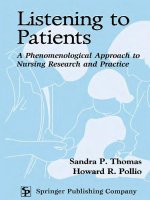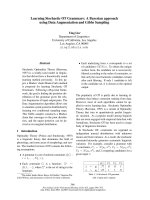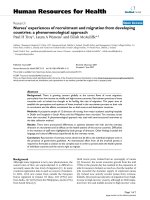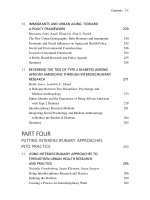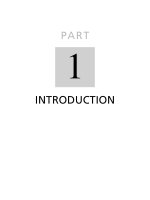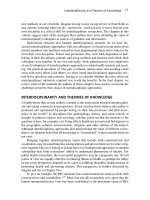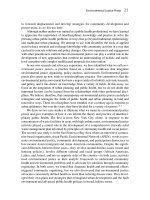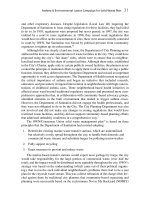Listening to Patients A Phenomenological Approach to Nursing Research and Practice
Bạn đang xem bản rút gọn của tài liệu. Xem và tải ngay bản đầy đủ của tài liệu tại đây (13.06 MB, 309 trang )
Listening to
Patients
A Phenomenological Approach
to Nursing Research and Practice
Sandra P. Thomas, PhD, RN, FAAN, is Professor and
Director of the PhD Program in Nursing at the University
of Tennessee in Knoxville. Her initial nursing preparation
was at St. Mary's Hospital School of Nursing. She holds
bachelor's, master's, and doctoral degrees in education,
majoring in educational psychology. She also earned a master's degree in nursing, with clinical specialization in mental health nursing; her nursing practice and research have
primarily focused on women's anger, stress, and depression.
Her program of research received the Chancellor's Award
for Research at the University of Tennessee. She is the editor of Issues in Mental Health Nursing and the author of over 80 journal articles, books,
and book chapters. She is a member of the American Nurses Association, the American
Psychological Association, and Sigma Theta Tau International. She is a board member
of the International Council on Women's Health Issues and a charter member of the
Southern Nursing Research Society. In 1996, she was named a Fellow of the American
Academy of Nursing. In 1999, she became a Fellow of the Society of Behavioral
Medicine,
Howard R. PeUio, PhD, is Alumni Professor of Psychology
at the University of Tennessee in Knoxville. He received his
bachelor's and master's degrees in psychology from
Brooklyn College and his PhD in experimental psychology
from the University of Michigan. His areas of specialization include learning and thinking, college teaching, figurative language, humor, and existential-phenomenological
approaches to psychology. He has published over 120 journal articles, book chapters, and books. He was the founding editor of the journal Metaphor and Symbol, He has been
president of the Southeastern Psychological Association and
a Phi Beta Kappa national lecturer. He is a Fellow of two divisions of the American
Psychological Association and has received a number of teaching and research awards.
Listening to
Patients
A Phenomenological Approach
to Nursing Research and Practice
Sandra P. Thomas, PhD, RN,FAAN
Howard R, Pollio, PhD
Springer Publishing Company
Copyright C 2002 by Springer Publishing Company, Inc.
All rights reserved
No part of this publication may be reproduce4 stored in a retrieval system, or
transmitted in any form or by any means, electronic, mechanical, photocopying,
recording, or otherwise, without the prior permission of Springer Publishing
Company, Inc.
Springer Publishing Company, Inc.
536 Broadway
New York, NY 10012-3955
Acquisition Editor: Helvi Gold
Production Editor: Jeanne Libby
Cover design by Susan Hauley
01 02 03 04 OS/ 5 4 3 2 1
Library of Congress Cataloging-in-Publkation Data
Thomas, Sandra P,
Listening to patients : a phenomenological approach to nursing / Sandra P.
Thomas, Howard R. Pollio.
p. cm.
Includes bibliographical references and index.
ISBN 0-8261-1466-0
1. Nurse and patient. 2. Existentialism. 3. Interpersonal communication.
4. Patients—Counseling of. 5. Nursing—Philosophy. I, Pollio, Howard R.
II. Title.
[DNLM: 1. Nurse-Patient Relations. 2. Attitude to Health.
3. Existentialism. 4, Patients—psychology. 5. Philosophy, Nursing.
WY87T4615L2001]
RT42.T48 2001
610.73'06'99—dc2!
2001034183
Printed in the United States of America by Sheridan Books, Inc.
This book is dedicated to the patients who shared their
experiences with us. We are hopeful that nurses
everywhere will hear their voices.
This page intentionally left blank
Contents
Preface
Acknowledgments
IX
xiii
I. Phenomenology and Nursing
1. The Patient, the Nurse, and the Philosopher;
Seeing Rose Through the Eyes of Merleau-Ponty
2. If a Lion Could Talk:
Phenomenological Interviewing and Interpretation
3
20
II. Nursing and the Human Experience of the Human Body
3.
The Human Experience of the Human Body
51
4. "It's Like Getting Kicked by a Mule":
Living With an Implanted Defibrillator
62
5. "Now It's Me and This Pain": Living With Chronic Pain
73
III. Nursing and the Human Experience of Other People
6. The Human Experience of the World of Others
97
7. "We AH Became Diabetics":
The Experience of Living With a Diabetic Sibling
109
8. "Walking in the Dark": The Experience of Living
With a Daughter Who Has an Eating Disorder
124
9. "She Became an Alien": The Father's Experience of
Living With Postpartum Depression
140
vii
viii
Contents
IV, Nursing and the Human Experience of Time
10. The Human Experience of Time
153
11. "One Day You're Working and the Next Day You're an Invalid":
Recovering After a Stroke
163
12. " The Point of No Return": Formerly Abused Women's
Eiperience of Staying Out of the Abusive Relationship
177
13. "It Was the Dark Night of the Soul":
Wresting Meaning From a Time of Spiritual Distress
190
V. Nursing and the Human Experience of the World
14. The Human Experience of the Non-Human World
205
15. "Eventually It'll Be Over": The Dialectic Between Confinement
and Freedom in the World of the Hospitalized Patient
214
16. "Like a Bunch of Cattle": The Patient's Experience of the
Outpatient Health Care Environment
237
Epilogue
253
References
259
Index
285
Preface
This book began with a casual remark, a jaunty little exchange between an experimental psyehologist-turned-phenomenologist (Howard) and a psychiatric nurse-turnedresearcher (Sandra) who had studied phenomenology with Howard in 1981 and later
developed a fuller appreciation of its relevance for the discipline of nursing. For nearly
a decade, the two of us have collaborated in leading an interdisciplinary phenomenology research group on Tuesday afternoons. Sparked by discussion among the group,
this book was conceived on one of those Tuesdays, Our brief exchange that afternoon
went something like this: "Why don't we write a book for nurses?" "Great idea! I'll
draft a prospectus." After Ursula Springer concluded that the prospectus had merit and
invited us to proceed with the book, a great deal of new learning and hard thinking
was required before we could complete it. The process of writing this book has deepened not only our knowledge and appreciation of existential phenomenology but also
our mutual respect for each other as scholars and as people.
At times we knew what we wanted to say to nurses but struggled to find ways to
say it. Writing is always a humbling experience. The philosopher Maurice MerleauPonty, on whom we rely heavily for inspiration, understood how writers must grope
for the right words to communicate with their readers. How true we found his observation that "writers experience the excess of what is to be said beyond their ordinary
capacities" (The Prose of the World, 1973, p, 57). At other times, we really did not
know what we thought about a topic until we wrote about it. Putting words on paper,
and then repeatedly revising them, eventually clarified our thoughts. Again, MerleauPonty was prescient: "Many writers . . . begin a book without knowing exactly what
they are going to put in it" (The Phenomenology of Perception, 1962, p. 177).
Eventually, all the words were on paper. It is our hope that readers will sense our passion for existential phenomenology and understand our conviction that it provides a
basis for a new dimension of nursing science and practice.
Who are the potential readers of this book? As we wrote, we thought of graduate
students and faculty, certainly, but we also meant to speak directly to clinicians, in all
specialty areas of nursing, who might be interested in hearing about a humanistic philosophy and research methodology that has the potential to illuminate the deeper meanings of health crises and universal human experiences such as pain and spiritual distress.
or
x
Preface
We would be greatly pleased if teachers of undergraduates selected this book as a text.
With this possibility in mind, we deliberately presented our material in a clear, jargonfree style accessible to anyone enrolled in college courses.
Every nurse hears patient stories, but not every nurse leams to listen to them in a
way that permits hearing their richness and power. What this book hopes to promote
is a method of hearing those stories and making meaning of the narratives within the
context of nursing practice. The book is organized into five major sections. Part One
introduces nurses to phenomenological thinkers, such as Merleau-Ponty, and applies
insights from philosophy to the processes of engaging in dialogue with patients and
interpreting what they tell us. In this introductory section, we begin the task of acquainting readers with the major contexts within which human existence is experienced (body,
other people, time, and world). Thereafter, a specific section of the book is devoted to
each of these contextual grounds of human life. In Part Two, for example, we examine philosophy, theory, and research about the body. In Part Three, we explore the
human experience of other people. In Parts Four and Five, we address the topics of
time and world, respectively. Compelling original research, conducted in a variety of
health care settings by members of the research team at the University of Tennessee,
is presented throughout the book. We anticipate that you will find the words of patients
and their families riveting as you read these research reports.
Although we realize that some readers may be drawn by clinical interests or personal curiosity to particular chapters and not proceed in the sequence we chose for
organizing our material, we urge a bit of caution. Chapters 1 and 2 provide essential
information about our philosophy and approach to phenomenological research; to
avoid redundancy, specific procedural details are not repeated in subsequent chapters.
Thus, we strongly suggest a careful reading of these chapters before proceeding. The
introductory chapters in each of the main sections of the book (Chapters 3,6,10, and
14) are also important in setting the stage for those chapters that immediately follow
them. In anticipation of various questions that may arise, we have used the term
"patient" rather than client, customer, or consumer, although no implication should
be drawn that we consider the recipients of nursing services as passively dependent
and unable to enter into a relationship of mutuality with caregivers. With regard to
protection of the rights of human subjects, all projects were approved by the
Institutional Review Boards of the university and the institutions where interviews
were conducted. To preserve patient rights to confidentiality, transcriptionists and
members of the phenomenology research group were asked to sign confidentiality
pledges for every project. Real names of interviewees never appear on the typed interview transcripts used by the research group in our weekly thematizing sessions. While
we do include verbatim quotes from patient interviews in this book, all names of institutions are removed and all names of persons appearing in the text are pseudonyms.
This is not the first book in nursing about phenomenology, but we hope it will prove
to be a useful addition to the extant body of literature on this topic. This book is unique
in its philosophical basis (Merleau-Ponty), its approach to clinical practice and research,
and its thorough coverage of the major existential grounds described by existential-
Preface
xi
phenomenologieal thought. We have sought feedback about its content and readability from more than a dozen colleagues, and we are now ready for you, our readers, to
enter into dialogue with us, scanning the pages we have written and critically reflecting on our ideas. We invite, and eagerly await, your response. Our hope is that we will
succeed in stirring both your thoughts and your emotions. In this time of distress and
turmoil produced by the corporatization of health care delivery systems, nurses are
burning out and patients are feeling abandoned. It is a time for us to engage in a deepening reflection about the fundamental meanings of a practice so intimately linked to
the most joyous and tragic experiences of human life. When nurses reflect deeply upon
their practice, our patients will surely be the ultimate beneficiaries.
This page intentionally left blank
Acknowledgments
The authors gratefully acknowledge the following individuals for their contributions
to this book, to our thinking, and to our richly satisfying personal and professional lives:
Stephen Krau
Dianne Briscoe
Marilyn Smith
Mitei Davis
Johnie Mozingo
Sharon Sarvey
Becky Fields
Molly Meighan
Pat Droppleman
Janet Secrest
Karen Reesman
Carol Smucker
Mona Shattell
Kristina Plaas
xm
This page intentionally left blank
I
Phenomenology and
Nursing
What is phenomenology? It may seem strange that this question has still to be asked
half a century after the first works of Husserl. The fact remains that it has by no means
been answered. Phenomenology is the study of essences; and according to it, all problems amount to finding definitions of essences: the essence of perception, or the
essence of consciousness, for example. But phenomenology is also a philosophy which
puts essences back into existence, and does not expect to arrive at an understanding of
man and the world from any starting point other than that of their 'facticity.' It is a transcendental philosophy which places in abeyance the assertions arising out of the natural attitude, the better to understand them; but it is also a philosophy for which the
world is 'already there* before reflection begins—as an inalienable presence; and all
its efforts are concentrated upon re-achieving a direct and primitive contact with the
world, and endowing that contact with a philosophical status.
—Maurice Merleau-Ponty, Phenomenology of Perception (1945/1962), p. vii
This page intentionally left blank
1
The Patient, the Nurse, and the
Philosopher: Seeing Rose
through the Eyes of
Merleau-Ponty
wo people are talking. One is a phenomenological nurse researcher; the other is
a woman who recently suffered a stroke. The researcher, Janet, speaks first: "Can
you describe for me some specific experiences you've had since your stroke that
stood out for you?" Rose, the patient, replies: "Well first of all, I was just devastated
that everything I had was taken away from me, you know—my jewelry, my money,
everything. . . . Yeah, one day you're working and the next day you're an invalid, so
you know, you think you're through."
"You think you're through?"
"You think you'll just never be a whole person again, when you realize you're paralyzed. When you can't move a finger or anything, you know."
"You didn't feel like a whole person?"
"Well, you know, I'm a person that tries to do the right thing for everyone, take care
of everybody. And I just couldn't understand . . . and . . . I said if I can't get better I
want to die. And if I can get better I will..., And like 1 said before, you have to want
to do things. If you want to sit in a wheelchair okay. So my husband pushed me down
to therapy the first day. And this big man approached me and said Tm here to help
you. I'll teach you to walk.' He said, 'You'll stand up and I will hold you and we'll go
around with the walker.' And I said, '1 can't do that,' He said, 'Well, you have the right
to choice. If you don't want to, that's your right. But I've never let a person fall, and I
want to help you. But you have to be willing to do it or you can sit in that wheelchair
the rest of your life.* So immediately, I said [to myself] 'Well look, you know, you got
to try.' And in three days I was walking . . . very slowly and very carefully, but I was
walking."
T
3
4
Phenomenology and Nursing
From this conversation, Janet Secrest (1997) came to the conclusion that the world
of the stroke survivor is one in which loss and effort are uniquely significant (see
Chapter 11). In addition, each of the survivors whom she interviewed described a sense
of discontinuity in the self: The stroke seemed to break the survivor's experience into
a pre- and post-stroke person. The anxiety evoked by such an experience is clearly evident in Rose's statement, "I'll never be a whole person again," But Rose did not talk
directly about who she is or was. Instead she began by describing how devastated she
felt when her personal possessions—her things—were taken away, The issue of time
came up next, with a clear contrast between a before ("One day you're working") and
an after ("The next day you're an invalid"). There also was an ominous concern for the
future: "And you think you're through." It is only at this point, however, that Rose
described a bodily component of what it meant to be through ("You're paralyzed .. .
can't move a finger or anything") and the personal significance of the paralysis ("[I
won't be able] to do the right thing for everyone" or "take care of everybody"). This
new way of being with people presents a problem for her. The narrative then comes
fall circle when Rose is told in physical therapy that she has the "right to choice," but
if she's willing to cooperate with the therapist she won't have to sit in the wheelchair
for the rest of her life. Rose's recovery requires other people, perhaps making her aware
for the first time that she doesn't always have to be the one who "takes care of other
people;" she can let them take care of her for a change.
This conversation is about Rose's concern over who she is both before and after a
stroke. She does not talk about her "self" as a collection of habits, memories, traits,
and skills encased inside her skin and separate from the world. What Rose does talk
about are her absent possessions, her changed relationships to other people, her personal past and possible future, and her limited ability to negotiate space in the physical world. We might say that Rose experiences her life in terms of other people,
personal objects, time, and her body's relationship to the world. Others, time, body,
and world, including personal objects, comprise the four major existential grounds of
human existence, the contexts against which human life and experience always emerge.
Because nursing is interested not only in how life progresses biologically but also in
how people experience their lives from their own, unique, first-person perspective, it
makes sense that we should be interested in the one contemporary philosophy-—existential phenomenology—explicitly concerned with these issues.
Although existential phenomenology has found its way into many nursing research
textbooks, it usually receives relatively brief mention, perhaps a few pages, or at most,
a single chapter. More often than not, it is presented to readers along with other inductive, qualitative research approaches that are also given a cursory overview by the
authors of these texts. In conjunction with several other qualitative methods, phenomenology shares an emphasis on: ( I ) respect for people, (whether patients or study participants), considering them as co-researchers and not as "subjects"; (2) the use of
in-depth interviewing to discover perceptions and feelings; and (3) rigorous interpretation of texts that result from such interviews. Its philosophical underpinnings, however, are unique and deserve careful examination—a task that may seem intimidating
The Patient, the Nurse, and the Philosopher
5
to nurses who lack a strong background in philosophy. Perhaps because of its European
origins and esoteric terminology, phenomenology sounds especially mysterious to readers encountering it for the first time. Many contemporary authors continue to sprinkle
their accounts of phenomenology with the German or French terms by which phenomenology was introduced, thereby creating additional difficulty for the reader who
is not fluent in these languages.
Nursing needs a more comprehensive, and comprehensible, presentation of this
philosophical tradition and research methodology. As a research method, it has great
value for studying those aspects of our patients' experiences that are not measurable
by blood pressure cuffs, rating scales, or questionnaires—such as the meaning of a
stroke to a woman like Rose. Even when experiences—such as stress—have been
deemed "measurable" by scientists, many questionnaires are not sensitive to cultural
and/or gender differences and fail to capture what is most salient to the individuals
responding to them. For example, no standard stress questionnaire measures vicarious
stress, which proved to be the number one stressor for women in a study by our research
team (Thomas & Donnellan, 1993). We had given the women a well-validated and reliable instrument, but we also asked them an open-ended question, permitting them to
describe their greatest distress in their own words. By doing so, we discovered the
shortcomings of the instrument and learned what was really causing them distress.
What bothered the women most were events that were happening to their significant
others, such as the impending divorce of a son, job problems of a husband, illness of
a sister or friend. In these stressful circumstances the women suffered empathically
along with their loved ones but had little or no control over what was happening. This
type of stress has received little attention in the vast literature based on administration
of standard stress questions about a person's own work, health, and finances (e.g., what
is the amount of your mortgage? how many times have you been to the doctor?)
Experiences such as this to us led our research team to become dissatisfied with
structured questionnaires and, eventually, drawn to phenomenological methodology for
our continuing studies of anger, stress, and depression (cf. duMont, Droppleman,
Droppleman, & Thomas, 1999; Fields et al., 1998; Thomas, McCoy, & Martin, 2000;
Thomas, Smucker, & Droppleman, 1998; Wood, Meighan, Thomas, & Droppleman,
1997). We joined the growing number of scholars in other disciplines who had become
disenchanted with the results of quantitative studies. Among the reasons for this disenchantment, Van Maanen (1982, p. 13) listed the following: (1) the relatively trivial
amount of variance explained by the researcher's selection of variables; (2) the abstract
nature of the key variables; (3) the lack of comparability across studies; (4) the failure
to achieve much predictive validity; (5) the high level of technical sophistication, rendering many research publications incomprehensible to all but a few readers; and (6)
the complexity of multivariate analysis, "which, even when understood, makes changeoriented actions difficult to contemplate."
While quantitative research is still of great value in discovering such things as precise changes in blood pressure, in millimeters of mercury, after a relaxation intervention, and we have no argument with the usefulness of many descriptive-correlational
6
Phenomenology and Nursing
and experimental studies of nursing phenomena, such studies cannot shed light on the
meaning of what is happening to those who are experiencing it. When our concern is
the meaning of human experience, we need to use a qualitative approach. Existential
phenomenology, in our view, is ideal for this purpose, A phenomenological approach
also enables us to explore the experience of children (e.g., Bennett, 1991; Erickson &
Henderson, 1992; Jacobson, 1994), frail elders (Porter, 1999a; Zalon, 1997), and so
many others who have rich stories to tell us—but only limited ability or interest in
responding to numeric rating scales. Nursing studies using a phenomenological
approach have focused on the lived experience of diverse disease conditions (e.g.,
addiction, anorexia, cancer) and symptoms (e.g., air hunger, pain, urinary incontinence)
as well as on more elusive phenomena such as empathy, courage, and caring (see Koch,
1995, or Carpenter, 1999a, for overviews of extant research).
Furthermore, we believe that phenomenology has profound relevance for our clinical practice as well as our empirics. Unfortunately, most of the extant research is "published in a language and in places that benefit researchers and not the patients and
practitioners" (Miller & Crabtree, 1998, p. 295). It is the staff nurse in the rehabilitation center who could listen to Rose's story, connect with her, and explore her concerns
and the deeper meanings of her health crisis. But no nurse was there for Rose. Perhaps
no nurse in that facility understood how to care for Rose in the most elemental sense
of the term caring.
Gergen (2000) contends that caring is not something the nurse does for the patient,
but something that is co-created and negotiated in interaction with the person, a coordinated dance between two human beings in a specific relationship. The patient must
teach the nurse how to care, and the nurse must listen—not only to the patient's words
but to his or her unspoken bodily response. Gergen gives the example of a perfunctory
back massage, delivered by a nurse who is just performing a task and whose focus is
on the technical aspects of effleurage hand movements. The patient experiences himself as being pummeled and prodded but not soothed. In contrast, the nurse who is
attuned to the patient's response continually adjusts the pressure of the touch and movements of the hands. In this latter type of encounter, tense muscles relax, pain ebbs, and
the patient feels cared for.
In a profession in which the essential purpose is to care (cf. Bishop & Scudder,
1999; Leininger, 1991; Newman, 1994; Watson, 1985) and to provide comfort (cf.
Kolcaba, 1995; Morse, 2000), nurses still lack an in-depth understanding of these phenomena. For too long we have considered patient complaints as problems to be solved,
using a linear hypothetico-deduetive thought process and specifying measurable outcomes for our interventions. And if we did not have sufficient time for the full careplanning process, a "standard" care plan could be printed by the computer and
appended to the chart. Nursing research, likewise, has traditionally proceeded from
defining a "problem," to operationalizing "variables," to statistical testing of the null
hypothesis, hoping for a probability value of .05 or less (so that "significance" could
be claimed for the results). Under this logic, nursing phenomena were reduced to a
The Patient, the Nurse, and the Philosopher
7
level that destroyed what the researchers had sought to explain (Robinson, 1995), In
fact, isolated variables no longer seemed to represent, or even connect, to the world of
everyday existence (Richardson, 1986). Sadly missing was careful scrutiny of the individual patient's experience in all of its complexity, urgency, and ambiguity. Research
and clinical practice are less fulfilling endeavors when pursued within such a depersonalizing and mechanistic framework.
Unfortunately, for much of nursing's history as a profession, medicine's mechanistic lens for seeing phenomena also has been nursing's lens. It is time for nursing to
change its lens (Watson, 1999). Benner (1999a) urges the profession to recover the
vision articulated by Florence Nightingale. Nursing has never completely fulfilled
Nightingale's vision because the service needs of hospitals and physicians "exploited
the nursing vision, twisted its roots and choked potential growth" (Reed, 2000, p. 129),
Reed calls for a nursing reformation based on an integrative philosophic perspective
that purposely links the art and science of nursing and recognizes it as a basic human
healing process. Jean Watson even wonders if "nursing" will still be an adequate word
for the radical transformations that must take place in our healing practices.
Learning about existential phenomenology can be profoundly transformational, as
our students and colleagues often report (see Post-Study Reflections at the end of each
chapter). We believe that we have developed a unique approach at the University of
Tennessee to the study of nursing phenomena, an applied phenomenology for nursing,
The lens we have chosen to guide our vision is based primarily on the philosophy of
Maurice Merleau-Ponty (1962). Our approach is different in several respects from
Heideggerian hermeneutics (cf, Benner, 1994; Diekelmann, 1992) and other phenomenological approaches that nurses have developed (cf. Parse, 1995) or used (cf. van
Kaara, 1966; van Manen, 1990). In addition to Merleau-Ponty, our thinking also has
been enriched by the contributions of other existential phenomenological philosophers
such as Husserl (1913/1931), Heidegger (1927/1962), Buber (1924/1970), and Gadamer
(1960/1975), to name just a few, and you will see their influence in these pages.
Exemplars from diverse studies conducted by nurse researchers over the past decade
will illustrate the tenets of our approach, and counterintuitive findings should prove
intriguing. We will take you into the familiar worlds of the hospital and the outpatient
clinic, guiding you to see them freshly, from the first-person perspective of the patients.
You will be dismayed, but perhaps not surprised, to learn how frequently patients perceive hospitals as inhospitable and clinics as cold and unfeeling. You will be immersed
in first-person narratives of experiences such as stroke, abuse, and spiritual distress.
As nurses, we often assume that we know what such experiences are like, and therefore presume that we can empathize with our patients. Phenomenology, however,
demands that we initially "bracket" (that is, attempt to set aside) all that we think we
know. Instead, we must enter humbly into the life world of the patient. We must listen
in respectful silence as he or she describes very private experiences. Inevitably, our
understanding of the other person's experience is radically altered through dialogue,
and insights regarding the deeper meaning of an experience often have been stunning
8
Phenomenology and Nursing
to us, even as phenornenologieal researchers. We have also learned that, once a nurse
adopts this way of engaging patients in dialogue, routinized clinical practice is impossible: Both the nurse and the patient are irrevocably changed. The relational elements
of nursing, described so beautifully by pioneers such as Peplau (1952) and Travetbee
(1971) are receiving heightened attention in contemporary practice (for example, see
Krauss, 2000). Why is this so? There are several reasons. The public is dissatisfied
with perfunctory examinations performed in 15 minutes by monosyllabic health care
providers. In fact, patients may be fortunate if they receive a 15-minute exam; one new
textbook for doctors and nurses touts "expert 10-minute physical examinations!"
Communication between patient and provider is often woefully one-sided, as in the following exchange between a medical student and an old man. In answer to the student's
question, "what brought you to the hospital?," the patient related, "I was ran down, my
wife died, she had a brain tumor, and I took care of her. I got run down and got a
cough." The medical student's wholly inadequate response consisted of asking, "So,
you have this cough, how long have you had it?" (Shorter & Katz, 1999, p. 159).
In a recent survey, two out of three Americans said they no longer hold physicians
in high regard and see health care facilities as slightly better than automotive repair
shops, although less satisfactory than supermarkets and airlines (Aiken, cited in
Thomas, 1998). In another survey, 79% of respondents agreed that "there is something
seriously wrong with our health care system" (National Coalition on Health Care, cited
in Thomas, 1998). People are being treated but not healed. They long for care providers
who are truly interested in them and willing to sit with them and spend time listening
to their concerns (Riemen, 1998).
Having such a care provider is especially important to the chronically ill patient
for whom the wonders of technology proffer no cure. With the demographics of our
aging population, the main focus of nursing practice now—and in the foreseeable
future—is the chronically ill patient. Nurses interact for many years with their
patients who have chronic conditions such as diabetes, arthritis, depression, and cardiovascular diseases—promoting optimal quality of life, rejoicing in small victories,
and sharing the sadness of setbacks along the way. It is the caring relationship that
facilitates patients' adaptation to the chronic condition. Having a caring "partner"
motivates patients to commit to difficult medication and dietary regimens, submit to
unpleasant procedures, and return month after month for appointments. Nurses,
moreso than physicians, are well suited to deliver relationship-centered care to the
chronically ill. Writes Peggy Chinn: "Medicine focuses on surgical and pharmacological interventions, with interpersonal interactions being an adjunct to these interventions. In contrast, technical interventions are viewed in nursing as being adjunct
to the primary interpersonal interactions" (1983, p. 397). We believe that existential
phenomenology, with its emphasis on deeply connecting with and understanding the
human being in his or her wholeness and specificity, has much to offer nursing at
this particular moment in our history.
The Patient, the Nurse, and the Philosopher
9
WHAT IS EXISTENTIAL PHENOMENOLOGY AND
HOW DOES IT APPLY TO NURSING?
Existential phenomenology blends the philosophy of existentialism with the methods
of phenomenology to produce rigorous and richly nuanced descriptions of human life
(Pollio, Henley, & Thompson, 1997; Valle & King, 1978). Existentialism is a philosophy about who we are and how we may come to live an authentic life. Its central concern is to prompt human beings to live with a keen awareness of both their freedom
and their responsibility in shaping the situation in which they are involved (Langer,
1989), Existentialism originated with Soren Kierkegaard in nineteenth-century
Denmark as a revolt against philosophy's traditional remoteness from life. As the story
goes, young Kierkegaard sat in a Copenhagen cafe smoking a cigar one Sunday afternoon in 1834, musing about his failure to make a contribution to the world. His cigar
burned out, and he lit another. Suddenly his mission became clear: to explore the difficulties of existence, beginning with his own inner torment, aloneness, possibilities,
and limitations (Bretall, 1946). Through the years, writers such as Jaspers (1955), Sartre
(1956), and Camus (1970) added their voices to the continuing discussion of basic
human issues such as anxiety, despair, choice, and commitment. In the words of Sartre,
upon founding a journal in 1945 with Merleau-Ponty, "We [were] hunters of meaning,
we would speak the truth about the world and about our own lives" (from Sartre's
Situations, cited in Moran, 2000, p. 397).
Lacking a systematic way to conduct their inquiries, twentieth-century existentialists turned to the methods of phenomenology, as developed by the German philosopher Edmund Husserl and further articulated by Martin Heidegger. Husserl first began
to use the term "phenomenology" in 1900, What he meant by the term was a rigorous new science in which there could be systematic investigation of those things that
we take for granted in everyday life (in what he called the "natural attitude"). His mission, like that of Kierkegaard, was to save philosophy from a "crisis" of stagnation
and insignificance (Jennings, 1986). Husserl saw himself as a Moses, leading his people to a new land of transcendental subjectivity (Moran, 2000). The domain of his
new science of phenomenology was consciousness, and its method was the careful
description of human phenomena. He was not content with theoretical analysis but
insisted upon returning to "the things themselves," in their very essences. Essences,
by definition, were patterns of meaning that were universal, unchanging over time,
and absolute (Jennings, 1986). The rigorous new science developed by Husserl called
for a shift in allegiance to "a valuing of enlargement rather than reduction, generosity rather than economy, complexity rather than simplicity, the lens rather than the
hammer (Psathas,1973, cited in Oiler, 1982, p. 181).
The phenomenologiea! movement has been described as a "set of waves" (Reeder,
1987) in a vast ground swell of "anti-reductionist and anti-constructionist" thinking
that had begun in the nineteenth century (Spiegelberg, 1981, p. xi). The history of the
10
Phenomenology and Nursing
movement is fascinating, especially if we delve into the personal circumstances underlying the views of its luminaries: Husserl, who was discriminated against for being a
Jew and grieved as the Nazis came to power and forbade him to teach; Sartre, who
joined the French Resistance and disputed Nazi authoritarianism with his writings about
the freedom of the individual; and Heidegger, who aligned himself with the Nazi regime
yet deplored the societal disintegration brought about by an increasing reliance on technology. It is beyond the scope of this book to review this history, but it is helpful to
know something about the disturbing context (i.e., Europe torn apart by the horror of
war) in which these philosophers pondered the meaning of human existence. No wonder they were intensely seeking the meaning of being; it was a frightening time in which
nothingness—which Sartre felt "lies coiled at the heart of human being like a worm"—
seemed imminent,
Nurses began to find the philosophy of existentialism relevant to clinical practice
in the 1960s, With its emphasis on the worth, responsibility, and potential of the unique
individual, the philosophy appealed to nurse writers such as Sister Madeleine Clemence
Vaillot (1966) and Anne Ferlic (1968). Both Vaillot and Ferlic viewed commitment as
an intrinsic characteristic of the professional nurse. Nurses must commit to give the
"whole of themselves" to individuals who are in need. Drawing from Gabriel Marcel,
Vaillot urged the nurse not to be a detached "spectator" but a "witness" to human suffering, freely choosing to be fully present and engaged with suffering humans. Ferlic
concluded that "existential thought seems the best philosophical foundation for the
contemporary nursing profession" (1968, p. 30).
Phenomenology surfaced in the nursing literature in the 1970s. Among the first
interpreters of phenomenological philosophy for scholarly inquiry in nursing were
Josephine Paterson and Loretta Zderad (1976), Rosemarie Parse (1981), Carolyn Oiler
(1982), and Anna Ornery (1983). These scholars, and others who followed, found in
phenomenology a method that enabled them to explore the chief concerns of the discipline: (a) the wholeness or health of human beings who continuously interact with
their environments, and (b) the patterning of human behavior in both normal and critical life situations (Fawcett, 1995). The phenomenological approach is compatible with
nursing's values and philosophical foundations. Research conducted from this perspective "becomes a caring act" (Munhall, 1994) capable of conferring therapeutic
benefit to the study participants (Hector, 2000).
DESCRIPTIVE AND INTERPRETIVE PHENOMENOLOGY
IN CONTEMPORARY NURSING
Most present-day nursing scholars either espouse adaptations of classical Husserlian
philosophy, most commonly referred to as "descriptive" or "eidetic" phenomenology
(cf. Drew, 1999; Porter, 1998), or Heideggerian hermeneutics, which is referred to as
